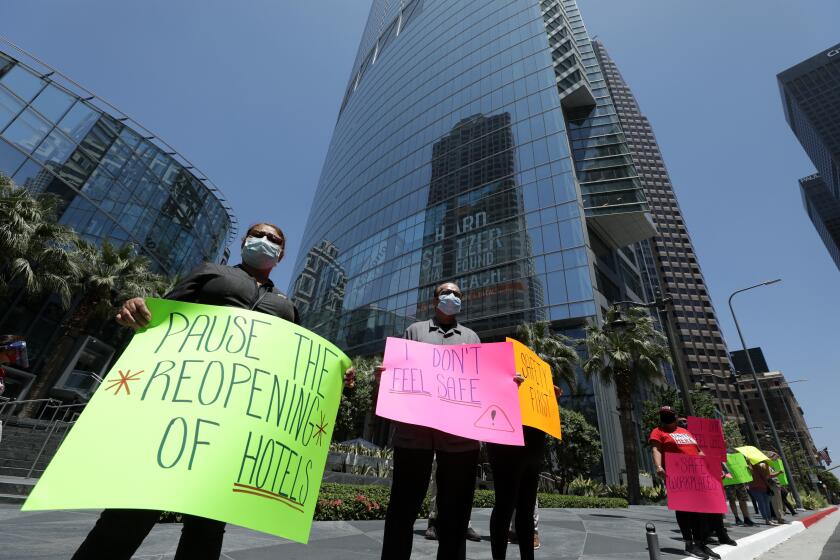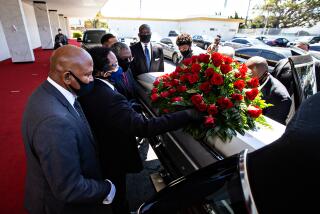California again breaks record for most coronavirus-related deaths in a single day
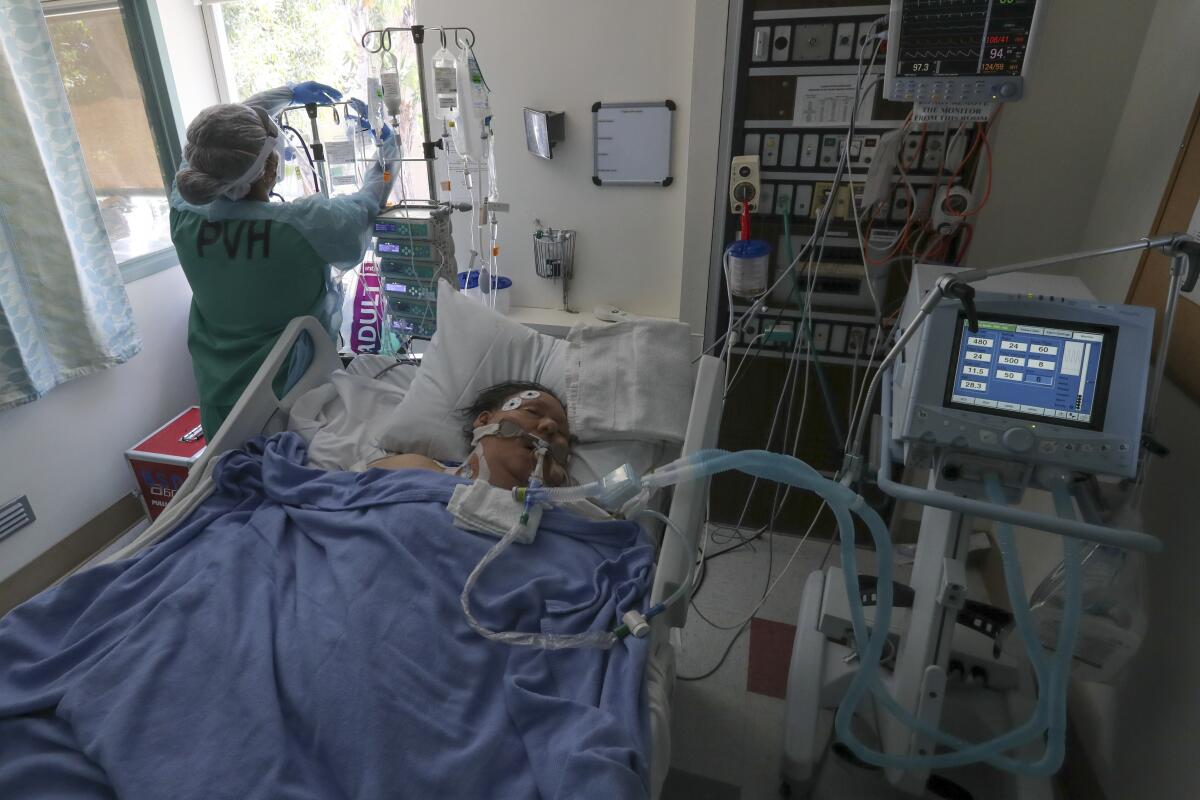
California has again broken a new record for the most coronavirus-related deaths in a single day, with 174 deaths reported on Tuesday.
It’s the third time this month that California has broken a single-day record for deaths and the second time in just a week, according to the Los Angeles Times’ California coronavirus tracker, which tallies cases and deaths from the state’s 58 counties. The previous single-day record was set on July 22, when 158 deaths were reported.
Since the first documented COVID-19 death in February, there have been 8,716 Californians who have died after a coronavirus infection. That’s nearly three times the death toll resulting from the great 1906 San Francisco earthquake, which killed more than 3,000 people.
The daily average of coronavirus-related deaths over the previous seven days has never been higher, now at 119.
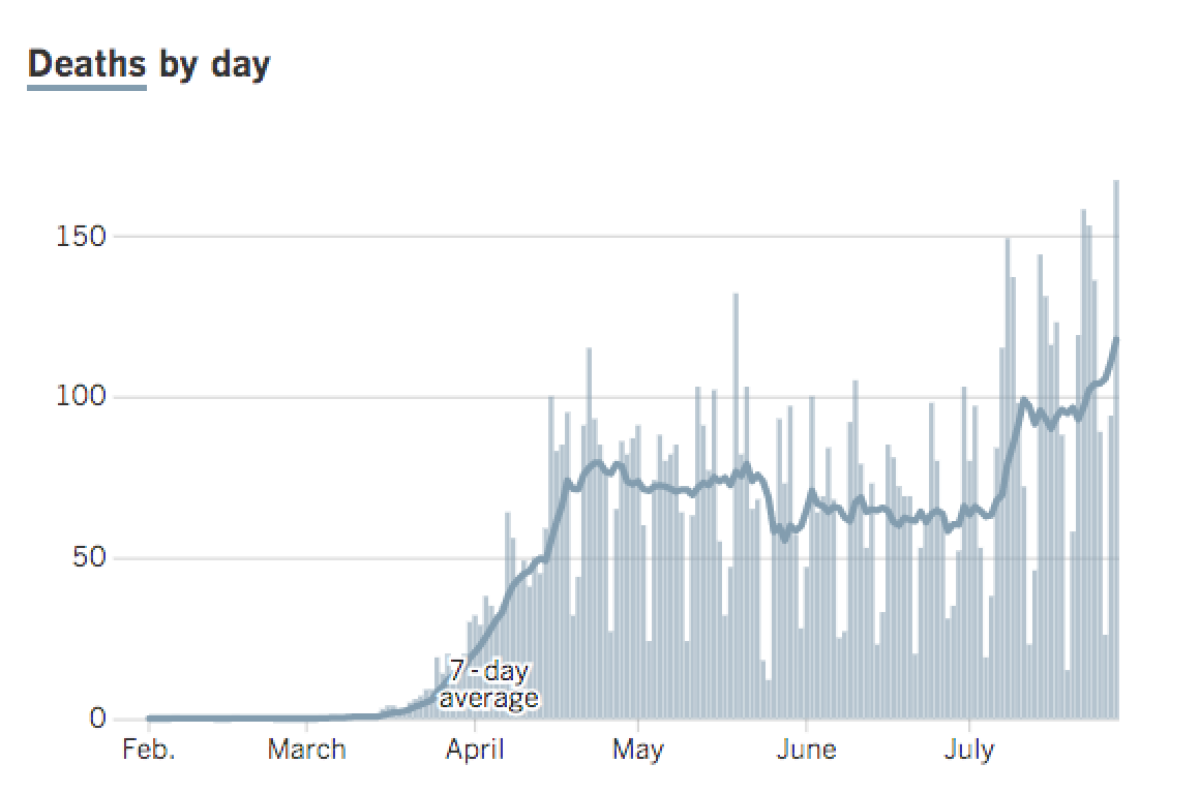
While much has been said about California’s death toll being far less than other U.S. states like New York — where 32,645 people have died — other nations have endured a far less severe death toll than California.
The cumulative coronavirus-related death toll in Japan is about 1,000; South Korea, 300; Australia, 167; New Zealand, 22; and Taiwan, 7. Japan and South Korea each have populations greater than that of California.
Across the U.S., more than 149,000 people infected with the coronavirus have died. No other country has a worse death toll.
Nationally, the U.S. has been recording an average of about 65,000 new cases a day, more than double the rate in mid-June.
By various measures, the coronavirus pandemic is now worse in many areas of California than it was in the week leading up to Memorial Day — some bleaker than others.
The San Joaquin Valley — an eight-county region of the Central Valley stretching from Stockton to Bakersfield — is one of the regions where pandemic conditions have deteriorated dramatically. In the week-long period that ended on Memorial Day, 42 residents of the San Joaquin Valley died from the coronavirus; in the seven-day period that ended Monday, 105 residents died.
Deaths are also on the upswing in the seven-county Sacramento region. Over the same time period, weekly deaths rose from 4 to 25.
The nine-county San Francisco Bay Area has seen its weekly death toll nearly triple in the same time period — from 20 to 57; San Diego County’s weekly death toll doubled over the same time period, from 28 to 55.
The five-county Southern California area — which includes L.A., Orange, Riverside, San Bernardino and Ventura counties — has seen weekly deaths increase from 357 to 493 in that same time period, an increase of 38%.
There are some signs that California’s most recent surge — while still growing — has started to slow down. On Tuesday, California was recording an average of 9,157 new confirmed cases daily over the past week, a 2% increase from the previous week. That’s a much slower increase than what happened on July 14, when the daily average of new cases over the past week was 8,902, a 20% jump from the previous week.
In addition, the rate at which coronavirus tests are coming back positive has been stable in recent weeks statewide. A Times analysis has found that California’s seven-day coronavirus positive test rate has generally stayed between 7% and 8% since July 5. Also, the effective transmission rate of the coronavirus statewide is estimated to be 1.02 — meaning every 1 infected person, on average, transmits the virus to 1.02 other people.
But looking at the average conceals the deep problems in harder-hit areas of California. In the San Joaquin Valley, the transmission rate of the virus is as high as 1.4, Dr. Mark Ghaly, the secretary of the California Health and Human Services Agency, said this week at a press conference in Stockton, “which tells us we have a great deal of work to do to get transmission rates down here in the Central Valley.”
In some hospitals in this part of the Central Valley, 65% of regular hospital beds are filled up with COVID-19 patients, Ghaly said. Federal medical teams have been dispatched to hospitals in the Central Valley and Southern California.
In the Central Valley, “you’re not anywhere close to being under control there,” said Dr. Kirsten Bibbins-Domingo, chair of UC San Francisco’s Department of Epidemiology and Biostatistics. “When we think of a state, our average numbers look better, but we cannot forget that in the middle of the state, the numbers look worse.”
The same problem can occur on the county level, where a county overall might look good, “but there are communities that still have high rates of transmission,” Bibbins-Domingo said.
“And unless we focus our attention on the areas where there is high rates of transmission, we are not going to get either the county or the state under control,” Bibbins-Domingo said. “And that’s one of the fallacies in California just constantly looking at the average effects, whether it’s statewide or within a county.”
And while there are some people in the state who have called COVID-19 a hoax, there are clear signs that this pandemic is, indeed, the worst global public health crisis in more than a century.
In Los Angeles County, the public health director, Barbara Ferrer, said COVID-19 is on track to be the second leading cause of death this year — ahead other natural causes like Alzheimer’s disease and stroke.
COVID-19 has already killed nearly triple the number of people in L.A. County than died from flu or pneumonia during the most recent eight-month flu season. Between October and May, 1,521 people died from the flu and pneumonia; as of Tuesday, 4,427 people have died from COVID-19 in L.A. County.
The daily number of healthcare workers reported to be infected with the coronavirus is also on the rise. As of Tuesday, there were an average of 310 healthcare workers getting infected with the coronavirus daily over the previous week in California — a number that has more than doubled since Memorial Day.
A total of 119 healthcare workers in California have died after being diagnosed with COVID-19. Officials have confirmed more than 22,000 healthcare workers who have been infected.
The disproportionate impact of COVID-19 by race and ethnicity is also growing. Latino residents of California have been infected at a cumulative rate of 1,087 cases per 100,000 Latino residents. That’s three times worse than the rate for white residents, which is 358 cases per 100,000 white residents.
Black residents of California are 51% more likely to have contracted the coronavirus than white residents, with a rate of 542 cases per 100,000 Black residents.
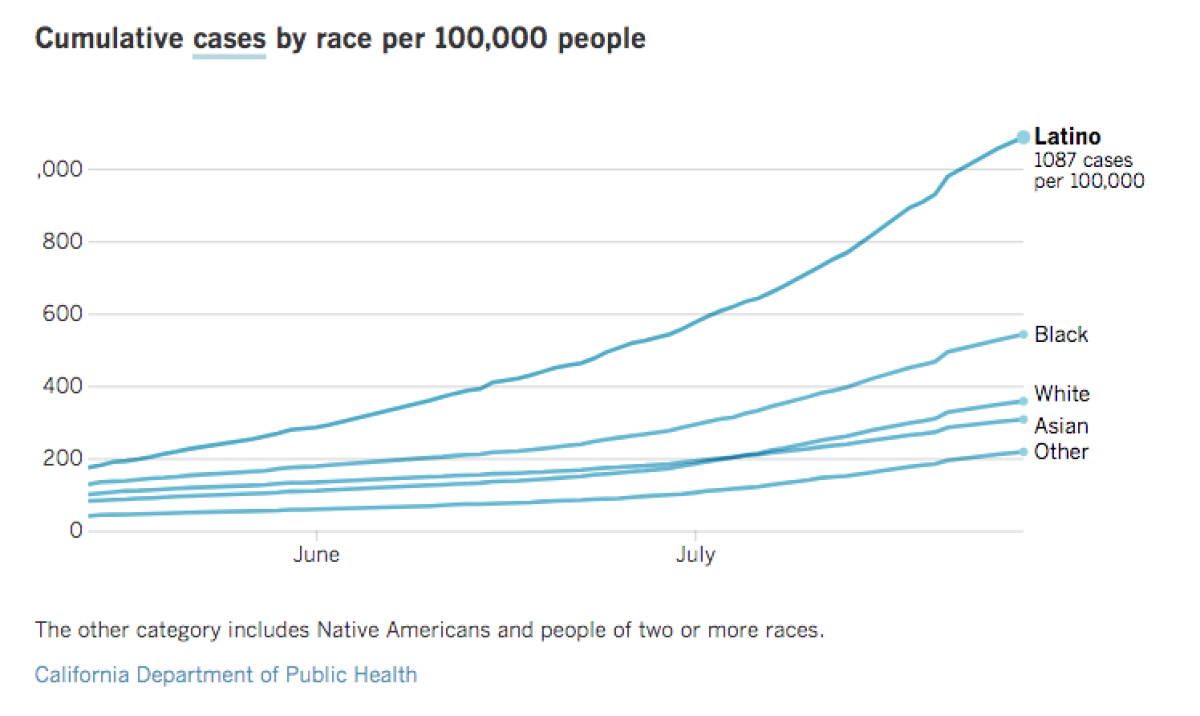
Black and Latino residents are also dying at disproportionate rates.
Black residents make up 6% of California’s population yet account for 8.5% of the state’s COVID-19 deaths. Latino residents make up 39% of California’s population yet make up 46% of deaths.
The disparity is particularly noticeable among working-aged Latino residents.
Of Californians aged 50 to 64, 65% of the coronavirus deaths have occurred among Latinos, even though Latinos make up only 32% of Californians in this age range.
Among Californians aged 35 to 49, Latinos made up 78% of coronavirus-related deaths, even though Latinos in that age range make up just 42% of the population.
And for Californian adults under the age of 35, Latinos represent 62% of coronavirus deaths, despite comprising 45% of the state’s population in that age group.
The youngest Black Californian adults are also dying from COVID-19 at a disproportionate rate, accounting for 15% of deaths, despite comprising 7% of the state’s population in this age group.
As most of California begins a second shutdown over the coronavirus outbreak, no place has been hit as hard as Imperial County.
Health experts are deeply concerned about outbreaks that have devastated largely Latino low-income essential workers across California, affecting workers in agriculture, factories and food processing facilities.
L.A. County’s largest outbreak, which infected more than 300 people and resulted in four deaths, forced the temporary closure of the garment factory Los Angeles Apparel.
Three more companies with outbreaks in L.A. County were ordered to shut down this week: S&S Foods of Azusa, Mission Foods Corp. of Commerce, and Golden State Foods Corp. of Industry. Each facility had outbreaks where at least 40 people were infected, L.A. County public health director Barbara Ferrer said Monday.
The companies did not notify the county once they had at least three coronavirus cases, Ferrer said, and the county is asking for better infection control protocols at all three sites, Ferrer said.
In the Central Valley, hundreds of workers have been infected at Ruiz Foods, a frozen-food packager in Tulare County, and Central Valley Meat Co., a meatpacking facility in Kings County.
Many, especially those backed by labor unions, push back against returning to their workplaces, citing employers’ failures to prevent COVID-19 outbreaks.
In Ventura County, hundreds of agricultural workers have tested positive, fueled in part by an outbreak at a housing complex that provides agricultural employers with temporary housing for their workers.
Outbreaks have also been a problem across other agricultural areas of California: the Imperial Valley east of San Diego, the Coachella Valley of Riverside County, the Salinas Valley and wine country in Northern California’s Sonoma, Napa, Solano, Mendocino and Lake counties.
Times staff writer Priscella Vega contributed to this report.
More to Read
Sign up for Essential California
The most important California stories and recommendations in your inbox every morning.
You may occasionally receive promotional content from the Los Angeles Times.
![]Paradise Valley Hospital in National City](https://ca-times.brightspotcdn.com/dims4/default/f47ae11/2147483647/strip/true/crop/5180x3453+0+0/resize/840x560!/quality/75/?url=https%3A%2F%2Fcalifornia-times-brightspot.s3.amazonaws.com%2F4a%2Fe7%2Ff4de9e1c408a8d9c7a0c35c7291e%2F566791-me-imperial-coronavirus-ik077.JPG)
